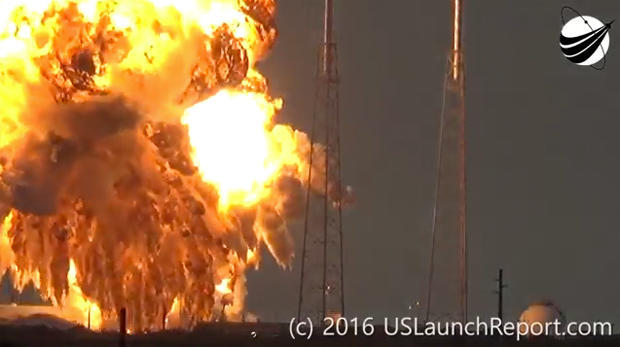High-stakes return to fight for SpaceX Falcon 9
SpaceX engineers are readying a powerful Falcon 9 rocket for a high-stakes return to flight Saturday, hoping to restore confidence in the low-cost booster after a spectacular launch pad explosion last September in Cape Canaveral. It was the company’s second failure in a year and a half.
Carrying 10 Iridium NEXT satellite telephone relay stations, liftoff from pad 4E at Vandenberg Air Force Base northwest of Los Angeles is targeted for 9:54:39 a.m. PST Saturday (GMT-8; 12:54 p.m. EST) Saturday.
If all goes well, the rocket’s first stage will attempt an autonomous landing on an offshore droneship while the second stage continues the climb to orbit. SpaceX has completed four successful droneship landings off the East Coast and two on a landing pad at the Cape Canaveral Air Force Station.
The only other attempt to land a stage on a droneship after takeoff from Vandenberg ended in failure last January when one of the booster’s four landing legs did not lock in place.
In any case, landing is a strictly secondary objective, part of company founder Elon Musk’s drive to lower launch costs by eventually re-using rocket stages. The primary goal of the mission is to boost the Iridium NEXT satellites into orbit, the first of seven SpaceX flights over the next year or so to deploy 70 relay stations for Iridium’s satellite telephone network.
While all rocket launches are critical to a company’s bottom line, a successful return to flight Saturday is especially important to SpaceX after an in-flight failure in June 2015 and the dramatic on-pad explosion Sept. 1 at Cape Canaveral.
The Falcon 9’s record of two failures in 29 rockets stands in contrast to the record of its major U.S. competitor, United Launch Alliance, which has launched 102 more expensive Atlas 5s and Delta 4s without a single failure. The European consortium Arianespace has successfully launched more than 75 Ariane 5s in a row.
“I have to be honest with you, every launch is a nerve-racking, significant emotional event,” Gwynne Shotwell, SpaceX president and CEO, told “CBS This Morning.” “But I think this flight will be a little more nerve-racking than normal.”
She said SpaceX currently has about 70 flights on its manifest, a backlog valued at some $10 billion. The Wall Street Journal reported Friday that a review of SpaceX documents and interviews with former employees shows the rocket builder lost $260 million in the wake of the 2015 in-flight failure, launching just six missions that year instead of 12 that were originally planned.
It’s not known what impact the September failure might have on the company’s bottom line or how delays will ripple through its manifest. SpaceX launched eight flights in 2016 and was forced to delay at least seven more.
But Shotwell said no customers have abandoned SpaceX and Bret Johnsen, SpaceX chief financial officer, said in a statement the company continues to enjoy “strong customer relationships.”
“Furthermore, with over $1 billion in cash reserves and no debt, the company is in a financially strong position and is well positioned for future growth,” he said.
The June 2015 failure, which destroyed a cargo ship bound for the International Space Station, was caused by a defective strut in the rocket’s second stage liquid oxygen tank. When the strut failed, a tank supplying helium gas used to pressurize the oxygen broke free, triggering the breakup of the second stage.
SpaceX engineers, working with NASA, the Air Force and the Federal Aviation Administration, carried out an exhaustive investigation to find out what caused the Sept. 1 explosion in Florida and to identify corrective actions.
They determined the most probable cause was the failure of one of the three high-pressure helium tanks in the rocket’s second stage oxygen tank.
“We learned a huge amount about the helium bottles,” Shotwell told CBS This Morning. “The failure ended up being quite subtle. We had to have a lot of test data and a lot of pretty high analysis to figure out what happened.”
The latest version of the Falcon 9, which debuted with the flight following the June 2015 failure, uses super-cooled, or “densified,” liquid oxygen and RP-1 kerosene fuel to provide additional performance during ascent.
Liquid oxygen normally has a temperature of around minus 298 degrees Fahrenheit, but SpaceX chills the propellant to around minus 340 degrees for use aboard the Falcon 9. The RP-1 kerosene fuel, which normally is stored at a room temperature 70 degrees, also is chilled.
The lower temperatures increase the density of the liquids and allow more propellant to be loaded.
To push propellants to the rocket’s engines, the Falcon 9 uses highly pressurized helium stored in aluminum bottles that are wrapped in a tough carbon composite material. The bottles, known as composite overwrap pressure vessels, or COPVs, are mounted inside the propellant tanks, submerged in the liquid oxygen and kerosene.
To achieve and maintain the desired low temperatures, propellant loading began just 35 minutes before launch.
On Sept. 1, about five minutes before a planned test firing of the Falcon’s nine Merlin 1D first stage engines -- a routine pre-launch test for SpaceX -- the second stage suddenly exploded in a spectacular fireball that was caught on video and widely seen around the world.
The rocket and it’s $200 million payload, a commercial communications satellite, were destroyed and launch complex 41 at the Cape Canaveral Air Force Station was heavily damaged. Just 93 milliseconds elapsed from the first signs of trouble to the explosion.
Investigators believe oxygen likely got trapped in voids between a second stage helium tank’s aluminum skin and its carbon composite overwrap. The extremely low temperatures in the oxygen tank may have caused some of the trapped oxygen to solidify.
In any case, the trapped oxygen pushing against the carbon overwrap likely generated friction “leading to ignition and the subsequent failure of the COPV,” SpaceX said in a statement.
Failure investigators “identified several credible causes for the COPV failure, all of which involve accumulation of super chilled LOX or SOX (solidified oxygen) in buckles under the overwrap,” the company said in its statement.
“The corrective actions address all credible causes and focus on changes which avoid the conditions that led to these credible causes. In the short term, this entails changing the COPV configuration to allow warmer temperature helium to be loaded, as well as returning helium loading operations to a prior flight proven configuration based on operations used in over 700 successful COPV loads.”
Shotwell said engineers “learned the behavior of these bottles” and “we’ve modified the way we load the propellants on the rocket and helium.”
For the Iridium launch, kerosene fuel loading will begin an hour and 10 minutes before launch with oxygen loading beginning 45 minutes before liftoff. The company carried out a successful fueling and first stage engine test firing a week ago.
“We learned more about the hardware,” Shotwell said, “which is always good. Whenever you have a failure, it’s a bigger failure if you don’t learn from it and modify the operations and your technology going forward.”
When all is said and done, rocket launches are “really hard. And the 5,000 or so people we have at SpaceX know it intimately,” Shotwell said.
“A million things have to go right in order to have a successful launch, and only one thing has to go wrong to have a particularly bad day,” she said. “It’s really hard, it is rocket science, and I’m sure all our customers feel that, too.”





